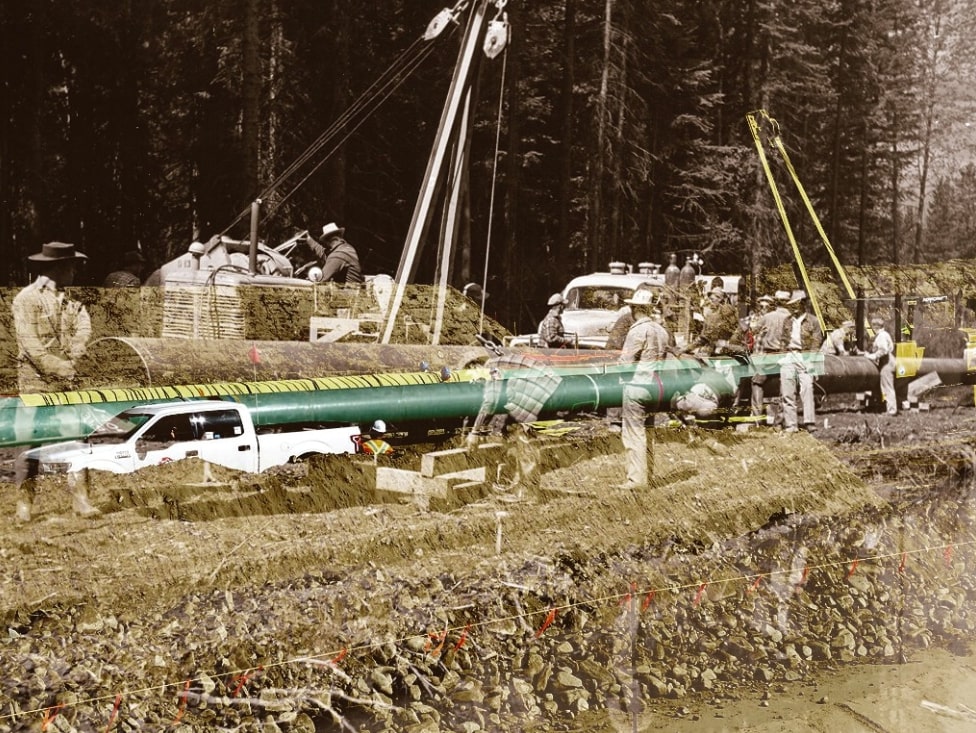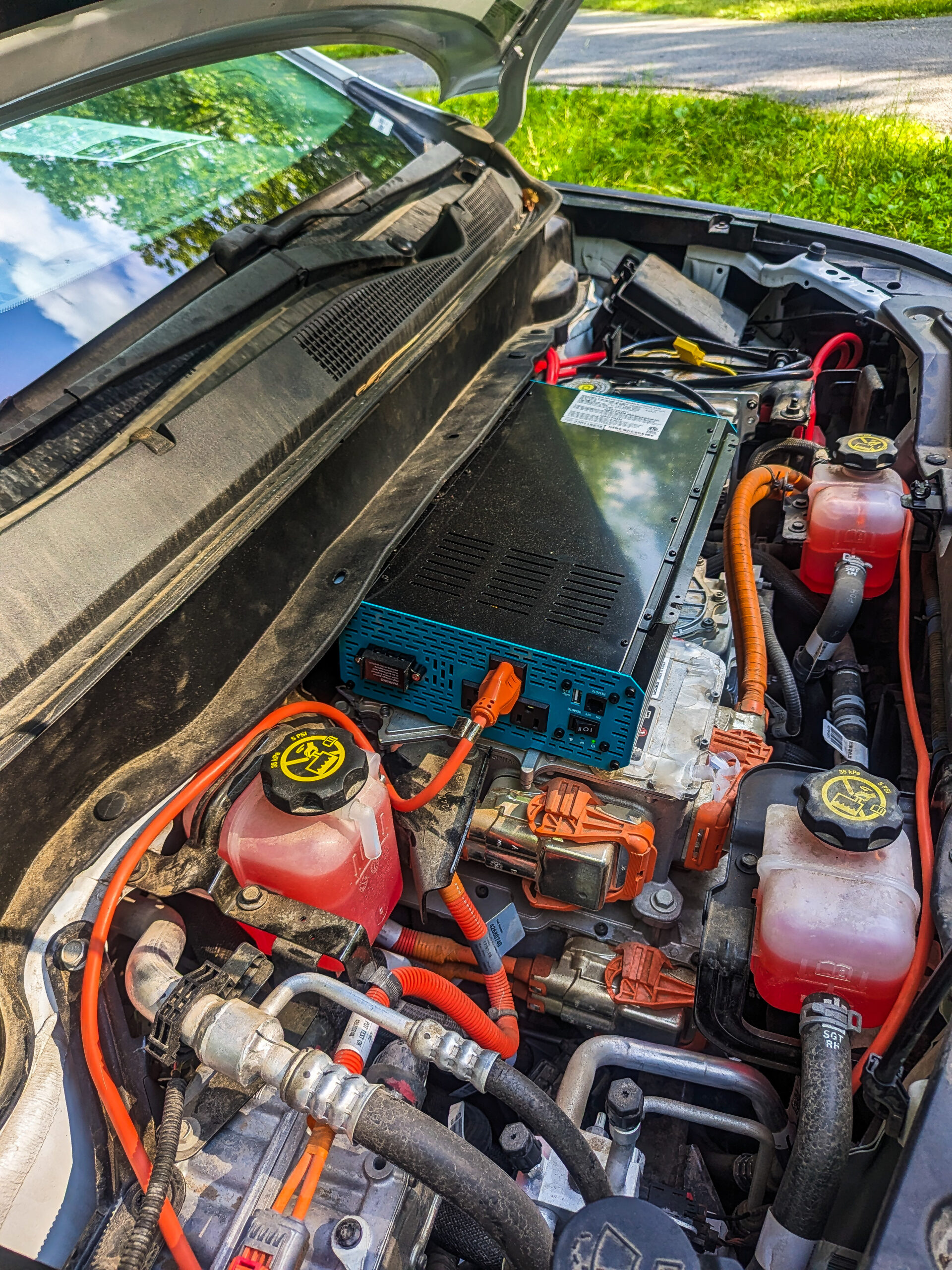Our oil is moving in the expanded TMX pipeline, finally.

By Resource Works
More News and Views From Resource Works Here
Oil is already filling the expanded Trans Mountain oil pipeline between Alberta and its Westridge marine export terminal in Burnaby B.C.
And tankers will be able to load with oil in mid-May — 71 years after the first shipment from the original pipeline.
The new “TMX” expansion comes at an estimated cost of $34 billion — more than six times the initial estimate of $5.4 billion.
“Today we landed the plane,” Trans Mountain CEO Dawn Farrell told The Calgary Herald on April, 30.
“I feel relieved and proud for Canada that we got something done that’s pretty magnificent. . . . Despite everything that happened that possibly could have happened — a pipeline that needed to come from Edmonton and go through the mountains, and cross under rivers, and cross under highways and go up steep slopes.”
John Ivison in National Post compared the completion of the project to the completion of the Canadian Pacific Railway in 1885.
The CPR, he wrote, is the kind of project that Canada no longer seems to be able to build.
“Except, the completion of the TMX is a reminder that Canada is still capable of greatness in the face of almost insurmountable odds.”
And he quoted our Stewart Muir: “Objectively, the completion of this project has to be the most influential act of national building in my lifetime.”
Muir noted that 28,246 people worked on the project, including more than 3,000 Indigenous Canadians and 2,604 women. At one point in 2022, 15,745 workers toiled to drive the pipeline through incredibly challenging, steep terrain in B.C.’s Interior.
And Muir told Business in Vancouver: “Despite controversies and cost overruns, the project as we have it today is financially healthy and will contribute positively to Canada’s economic, environmental and energy strategies in the coming decades.”
Much to the horror of green activists and protesters, they (and you) are the owners — as the federal government has been the owner of record since May 29, 2018.
Prime Minister Trudeau’s explanation: Ottawa stepped in because Kinder Morgan “wanted to throw up their hands and walk away,” and his government wanted to make sure that Canadian oil could reach new markets.
Economist Trevor Tombe of the University of Calgary has positive answers to the question of whether it was worth the high price.
“Whoever or whatever is to blame for the delays and cost overruns, the answer to that question is clear: Yes! And it’s not even close.
“I say this for two main reasons. First, taxpayers are not on the hook in the way that most people think. Indeed, we may not lose any money on the purchase at all. Second, and more importantly, the pipeline’s economic benefits to Canada far surpass its cost.”
Tombe added: “Last month, the Bank of Canada predicted a 0.25 percentage point increase in second-quarter growth from the new pipeline. That is no small move for a nearly $3 trillion economy. . . .
“Looking ahead, the gains may be even larger.”
While the feds have long spoken of selling the pipeline, but that may take a while. Ottawa will soon begin collecting tolls on the oil running through the line, and that could amount to close to $4 billion a year.
As well, a number of First Nations are looking to obtain equity shares in the pipeline, and thus benefits from it. The federal government has promised them financial support so “they don’t have to risk any of their own money to participate.”
Indeed, many Indigenous leaders in the oilsands region are looking forward to TMX’s opening.
And as Indigenous commentator Joseph Quesnel noted: “’Now that the Trans Mountain expansion is finally completed, it will provide trans-generational benefits to First Nations involved. . . .
“As of March 2023, the project had signed agreements with 81 Indigenous communities along the proposed route, worth $657 million, and the project has created over $4.8 billion in contracts with Indigenous businesses.”
The pipeline expansion will triple the volume of the existing Trans Mountain pipe to 890,000 barrels of crude a day, the equivalent of 1,300 railcars. It consists of 980 kilometres of new pipe, 12 new pumping stations and 19 new storage tanks, mainly at the marine terminal.
And oil producers in Alberta see much good news coming from it.
Cenovus Energy, for one, has its eyes set on a “pretty vast market,” that is expected to give oil producers access to better prices and newer markets.
Alberta’s Canadian Energy Centre sees this: ‘We’re going to be moving into a market where buyers are going to be competing to buy Canadian oil.”
It adds: “Customers for the first shipments include refiners in China, California and India, according to media reports.
“Shippers include all six members of the Pathways Alliance, a group of companies representing 95 per cent of oil sands production that together plan to reduce emissions from operations by 22 megatonnes by 2030 on the way to net zero by 2050.”
While Cenovus forecast TMX will be Canada’s last oil pipeline, oilsands production is rising so rapidly that some market players think Canada could again run out of pipeline space in less than two years, said RBN Energy analyst Martin King.
“Originally it was thought TMX would give us a four- or five-year window,” King said. “It now looks like that window of spare capacity might actually be a lot smaller.”
Trans Mountain says it has capacity to load each month 34 Aframax tankers the biggest the Port of Vancouver can handle. These can carry 500,000 to 800,000 barrels of oil, but ship brokers and analysts have expressed concerns about pilot and tug boat availability and loading restrictions.
Here’s a timeline of the project, expanded and updated from an initial timeline from Western Wheel news in Alberta:
- March 21, 1951: The Trans Mountain Pipeline Company is established via a charter granted by the Parliament of Canada, with the intent of building a pipeline to carry oil from Alberta to the West Coast.
- Oct. 17, 1953: The first shipment of oil reaches the Trans Mountain Burnaby Terminal, following a feat of engineering that saw the construction and completion of the pipeline in just 30 months. There has not been a marine spill since.
- Feb. 21, 2012: The Canadian division of U.S. pipeline giant Kinder Morgan Inc., which bought the Trans Mountain pipeline in 2005, announces it intends to expand the pipeline — the TMX project — after receiving support from Canadian oil shippers.
- Dec. 16, 2013: Kinder Morgan Canada formally files to the then-National Energy Board for regulatory approval for the project, which will nearly triple the pipeline’s capacity from 300,000 barrels per day to 890,000 barrels per day. The company pegs the capital cost of the project at $5.4 billion.
- November 2014: Hundreds of Indigenous and environmental protesters who oppose the proposed pipeline expansion are arrested for interfering with preliminary drilling and survey work taking place on Burnaby Mountain in B.C. Most of the charges are later dropped.
- May 29, 2016: The NEB recommends approval of the pipeline, subject to 157 conditions, concluding that it is in the public interest.
- Nov. 29, 2016: Prime Minister Justin Trudeau announces his cabinet has approved the Trans Mountain project, subject to 157 conditions aimed at addressing potential Indigenous, socio-economic and environmental impacts.
- May 25, 2017: Kinder Morgan announces its final investment decision, saying it will proceed with the Trans Mountain pipeline expansion as long as it secures satisfactory financing for the project through its initial public offering.
- Jan. 17, 2018: Kinder Morgan Canada warns the Trans Mountain expansion project could be a year behind schedule. The company says the project, which is now estimated to cost $7.4 billion, is looking at a December 2020 in-service date. The company also warns that if the project continues to face unreasonable regulatory risk, including opposition from the B.C. NDP government, it may not proceed at all.
- Jan. 30, 2018: B.C. government moves to restrict any increase in diluted bitumen shipments until it conducts more spill response studies, a move that increases the uncertainty for Trans Mountain.
- April 8, 2018: Kinder Morgan Canada suspends non-essential spending on the Trans Mountain expansion project and sets a May 31 deadline to reach agreements with stakeholders.
- May 29, 2018: The federal government announces a deal to buy the pipeline and expansion project from Kinder Morgan Canada for $4.5 billion.
- November 2019: Construction begins in the Edmonton area.
- Feb. 7, 2020: Trans Mountain CEO Ian Anderson announces that the cost of building the pipeline expansion has soared from an initial estimate of $7.4 billion to $12.6 billion, due to increased material and labour costs, legal costs and increased Indigenous consultations.
- Feb. 18, 2022: Trans Mountain Corp. hikes the estimated cost of the project to $21.4 billion, citing the COVID-19 pandemic and flooding in B.C. as well as other factors, and pushes back the projected completion date to the third quarter of 2023. Finance Minister Chrystia Freeland vows the federal government will put no more public money toward the project.
- June 2022: A report from the Parliamentary Budget Officer concludes the federal government stands to lose money from its investment in the pipeline, and suggests that if the project were cancelled now, the government would need to write off more than $14 billion in assets.
- March 10, 2023: Trans Mountain Corp., now headed by CEO Dawn Farrell following the retirement of Ian Anderson, pegs the new cost of the project at $30.9 billion. Construction is now 80 per cent complete, and the company says the pipeline will be in service in the first quarter of 2024.
- August 2023: Trans Mountain Corp. applies to the Canada Energy Regulator for permission to alter the route and construction method for a 1.3-kilometre stretch of pipeline in B.C., saying it has run into engineering difficulties related to the drilling of a tunnel. The application is opposed by the Stk’emlúpsemc te Secwépemc Nation (previously known as the Kamloops Indian Band), whose traditional territory the pipeline crosses and who had only agreed to the originally proposed route and construction method.
- Sept. 25, 2023: The Canada Energy Regulator approves Trans Mountain Corp.’s application to modify the pipeline’s route, sparing the project from what the pipeline company had warned could be a nine-month delay if its request was not granted.
- Oct. 31, 2023: Trans Mountain Corp. applies to the Canada Energy Regulator for a pipeline variance, saying it wants permission to change the diameter, wall thickness, and coating of a 2.3-kilometre segment of the pipeline due to difficulties drilling into hard rock in B.C.
- Dec. 5, 2023: The Canada Regulator denies that request over concerns about pipeline quality and integrity.
- Dec. 14, 2023: Trans Mountain asks the regulator to reconsider and warns of a potentially “catastrophic” two-year delay for the project if a variance is not granted and it is forced to proceed with its original construction plans.
- Jan. 12, 2024: After an oral hearing in Calgary, the Canada Energy Regulator agrees to grant Trans Mountain a pipeline variance. It imposes a number of conditions related to pipeline testing and documentation requirements.
- Jan. 29, 2024: Trans Mountain Corp. issues a statement on its website that it has run into “technical issues” during construction work in the Fraser Valley between Hope and Chilliwack, B.C. and needs additional time to determine the “safest and most prudent actions for minimizing further delay.” The company says it is now aiming for an in-service date in the second quarter of 2024.
- Feb. 1, 2024: Trans Mountain announces that the pipeline will be at full capacity, and shippers actually want to move 17% more oil through the pipeline than it can handle.
- Feb. 27, 2024: Trans Mountain says it expects the project’s cost to rise 10%, but it has firm service contracts with shippers starting on May 1.
- March 4, 2024: Oil producer MEG Energy said line-filling on the oil pipeline expansion would start from April.
- March 29, 2024: Trans Mountain successfully completed the pipe pullback for the Mountain 3 Horizontal Directional Drill (HDD) in the Fraser Valley between Hope and Chilliwack BC.
- April 29, 2024: Indian oil refinery Reliance Industries buys 2 million barrels of oil to come via the pipeline.
- April 30, 2024: The Canada Energy Regulator gives the go-ahead for the project to open, though with six leave-to-open permits still required. And there are 19 government-set conditions Trans Mountain must meet during its operations.
- May 1, 2024: Trans Mountain announced that the final “golden weld,” took place April 11 in B.C.’s Fraser Valley. And the company said tankers will be able to receive oil by mid-May. “As of April 30, 2024, the expanded pipeline is 70 per cent full by volume, and 69 per cent complete by distance.”
Share This:




